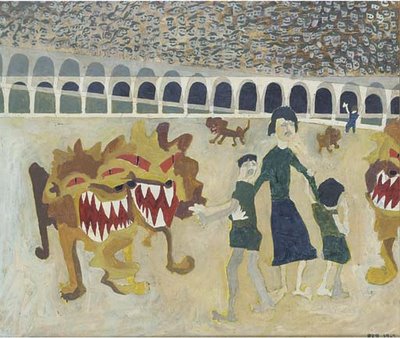What's all the fuss about?

Syd Barrett's recording career lasted little more than five years, and spawned about five albums' worth of material. Yet Barrett was able to live out the last 35 years of his life as a recluse in a leafy suburb of Cambridge on the royalties earned by these recordings, and also earn a critical reputation greater than those enjoyed by many musicians who have recorded fifty albums over five decades.
The huge response to Barrett's death this week (for starters, check out some of the links at the bottom of this obituary) is in part testament to the legend that grew up around lurid stories of drug abuse and mental illness, but it is also a sign of the genuine awe that his slim body of work has inspired in successive generations of listeners. In his short and disjointed career Barrett managed to pioneer at least half a dozen styles of music, from prog rock to Britpop to psych folk, with an ease that disarmed contemporaries and still communicates itself to listeners today.
If you're wondering what all the fuss is about, a good place to start is this page, where you can watch some film clips of Syd doing his thing with the first incarnation of the Pink Floyd. You can watch the recently recovered film clip that accompanied the Floyd's first single 'Arnold Layne', a song which David Bowie credits with kickstarting his career by providing a template for a new type of English pop music that mixed social realism and fantasy.
The followup to 'Arnold Layne' was 'See Emily Play'; Ian Broudie of the Lightning Seeds described it as 'the most perfect pop song imaginable', and you can watch the Floyd perform it at youtube.
By the time the band released their third single, the pocket symphony 'Apples and Oranges', they had already released their first and best album, The Piper at the Gates of Dawn (check out its mindblowing opening track here), and seen their songwriter and frontman begin his descent into madness. To see Barrett performing this song on youtube is to watch a man on the brink of an abyss.
'Jugband Blues', Syd's only contribution to the second Pink Floyd album, is a postcard from the abyss - watch out for the performance in the middle by a Salvation Army brass band that Barrett dragged into the studio and ordered to 'make up something' on the spot.
Throughout his long years of retirement in Cambridge, Barrett was pursued by fans and journalists who saw him as England's most famous recluse - as some sort of English JD Salinger, perhaps. I half-hoped to catch a glimpse of the man during the time I spent in Cambridge last year. Now that Barrett is dead, it's perhaps not inappropriate to advertise this film of him walking around Cambridge in 1998.
Although Barrett abandoned music in the early 70s, he continued to pursue his original passion of painting for the rest of his life, and a few examples of his work have made their way into private collections and onto the internet (an example is reproduced below). Hopefully the rest of this body of work will eventually find its way into the light of day.


1 Comments:
Sigh. Part of my childhood -- well, my early teens, at any rate -- has died.
It's amazing how Pink Floyd kept getting more ponderous -- and more pretentious -- after Syd was kicked out. I'll take "Piper At The Gates of Dawn" or "Barrett" or "The Madcap Laughs" over "Dark Side of the Moon" anyday.
I've got a bike you can ride it if you like...
Post a Comment
<< Home